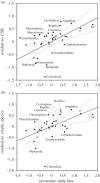Taxonomic distribution of cryptic diversity among metazoans: not so homogeneous after all
- PMID: 27555648
- PMCID: PMC5014032
- DOI: 10.1098/rsbl.2016.0371
Taxonomic distribution of cryptic diversity among metazoans: not so homogeneous after all
Abstract
Cryptic diversity plagues estimates of biodiversity, conservation efforts and attempts to control diseases and invasive species. Here, we re-visit a decade-old assessment of whether or not cryptic species are homogeneously reported among higher metazoan taxa. We compiled information from an extensive survey of the literature to recover all reports of cryptic species among metazoans. After correcting for currently known species richness and research effort per taxon, we find that cryptic species are over-reported in some taxa and under-reported in others. Although several taxa showing either a lack or an excess of reported cryptic species were poorly studied invertebrate groups, we found that cryptic species were over-reported in amphibians, reptiles and crustaceans, all relatively well-studied groups. The observed heterogeneity in the distribution of reported cryptic species may reflect taxon-specific properties affecting either the propensity for cryptic species to be formed or their likelihood of being detected by conventional taxonomy. Either way, the implications of cryptic diversity may not apply equally across all taxonomic groups.
Keywords: biodiversity; cryptic species; study effort; taxonomy.
© 2016 The Author(s).
Figures


References
-
- Loxdale HD, Davis BJ, Davis RA. 2016. Known knowns and unknowns in biology. Biol. J. Linn. Soc. 117, 386–398. (10.1111/bij.12646) - DOI
MeSH terms
LinkOut - more resources
Full Text Sources
Other Literature Sources
